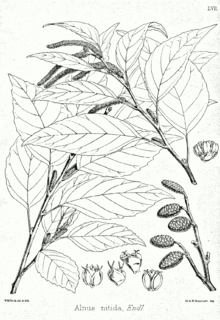Alnus nitida: Difference between revisions
Added bit about medicinal use |
Citation bot (talk | contribs) Add: doi-access. | Use this bot. Report bugs. | Suggested by LeapTorchGear | Category:Alnus | #UCB_Category 16/28 |
||
| (5 intermediate revisions by 2 users not shown) | |||
| Line 2: | Line 2: | ||
{{Speciesbox |
{{Speciesbox |
||
| image = Alnus nitida Bra57.png |
| image = Alnus nitida Bra57.png |
||
| image_caption = Botanical illustration |
| image_caption = Botanical illustration |status = LC |
||
| status = LC |
|||
| status_system = IUCN3.1 |
| status_system = IUCN3.1 |
||
| status_ref = <ref>{{cite iucn | |
| status_ref = <ref>{{cite iucn |vauthors=Shaw K, Roy S, Wilson B |year=2014 |title=''Alnus nitida'' |volume=2014 |page=e.T194659A2356455 |doi=10.2305/IUCN.UK.2014-3.RLTS.T194659A2356455.en |access-date=3 May 2021}}</ref> |
||
| genus = Alnus |
| genus = Alnus |
||
| species = nitida |
| species = nitida |
||
| Line 13: | Line 12: | ||
}} |
}} |
||
'''''Alnus nitida''''', |
'''''Alnus nitida''''', the '''west Himalayan alder''', is a species in the genus ''[[Alnus]]'', native to Pakistan, the western Himalayas, and Nepal.<ref name="294962-1" >{{cite web |url=http://powo.science.kew.org/taxon/urn:lsid:ipni.org:names:294962-1 |title=''Alnus nitida'' (Spach) Endl. |author=<!--Not stated--> |date=2017 |website=Plants of the World Online |publisher=Board of Trustees of the Royal Botanic Gardens, Kew |access-date=21 December 2020}}</ref> It is a tree reaching 20 to 25{{nbsp}}m, preferring to live along the banks of rivers. It is used locally for timber and firewood, and as a [[street tree]].<ref>{{cite journal |vauthors=Khan MK, Muhammad N, Uddin N, Ali N, Umer M, Ullah S |title=Genetic diversity in threatened plant species ''Alnus nitida'' (Spach.) Endel |year=2020 |journal=Plant Science Today |volume=7 |issue=3 |pages=314–318 |doi=10.14719/pst.2020.7.3.759 |doi-access=free}}</ref> The bark is used in some places for tanning and dyeing purposes.<ref name=":0" /> It grows well in heavy, clay soils and tolerates infertile soils.<ref>{{Cite web |title=''Alnus nitida'' - Useful Temperate Plants |url=http://temperate.theferns.info/plant/Alnus+nitida |access-date=2021-05-03 |website=temperate.theferns.info}}</ref> The leaves are thin, oval to ovate, 3-6 inches long and 2-3 inches wide.<ref>{{Cite web |title=''Alnus nitida'' - Trees and Shrubs Online |url=https://treesandshrubsonline.org/articles/alnus/alnus-nitida/ |access-date=2021-05-03 |website=treesandshrubsonline.org}}</ref> Female flowers appear first, followed by male [[catkins]]s in September to October, which may be up to 19 cm long.<ref name=":0">{{Cite web |title=''Alnus nitida'' in Flora of Pakistan @ efloras.org |url=http://www.efloras.org/florataxon.aspx?flora_id=5&taxon_id=242420274 |access-date=2021-05-03 |website=www.efloras.org}}</ref> The fruits are woody cones, typically 2.5-3.5 cm long.<ref>{{Cite web |title=Fact Sheet: ''Alnus nitida'' |url=http://idtools.org/id/dried_botanical/factsheet.php?name=9 |access-date=2021-05-03 |website=idtools.org}}</ref> |
||
This tree may be attacked by the apple stem borer (''Trirachys holosericeus'').<ref>{{Cite web|title=Alnus nitida (West Himalayan alder)|url=https://www.cabi.org/isc/datasheet/4588|access-date=2021-05-03|website=www.cabi.org}}</ref> |
This tree may be attacked by the apple stem borer (''[[Trirachys holosericeus]]'').<ref>{{Cite web |title=''Alnus nitida'' (West Himalayan alder) |url=https://www.cabi.org/isc/datasheet/4588 |access-date=2021-05-03 |website=www.cabi.org}}</ref> |
||
In some places, the bark is used as an anti-inflammatory. One study examined its chemical components and concluded it has antioxidant potential.<ref>{{ |
In some places, the bark is used as an anti-inflammatory. One study examined its chemical components and concluded it has antioxidant potential.<ref>{{cite journal |vauthors=Sajid M, Khan MR, Shah NA, Shah SA, Ismail H, Younis T, Zahra Z |title=Phytochemical, antioxidant and hepatoprotective effects of ''Alnus nitida'' bark in carbon tetrachloride challenged Sprague Dawley rats |journal=BMC Complementary and Alternative Medicine |volume=16 |issue=1 |pages=268 |date=August 2016 |pmid=27488054 |pmc=4972964 |doi=10.1186/s12906-016-1245-3 |doi-access=free }}</ref> |
||
==References== |
== References == |
||
{{Reflist}} |
{{Reflist}} |
||
Latest revision as of 12:23, 28 August 2023
| Alnus nitida | |
|---|---|

| |
| Botanical illustration | |
| Scientific classification | |
| Kingdom: | Plantae |
| Clade: | Tracheophytes |
| Clade: | Angiosperms |
| Clade: | Eudicots |
| Clade: | Rosids |
| Order: | Fagales |
| Family: | Betulaceae |
| Genus: | Alnus |
| Species: | A. nitida
|
| Binomial name | |
| Alnus nitida | |
| Synonyms[3] | |
|
Clethropsis nitida Spach | |
Alnus nitida, the west Himalayan alder, is a species in the genus Alnus, native to Pakistan, the western Himalayas, and Nepal.[3] It is a tree reaching 20 to 25 m, preferring to live along the banks of rivers. It is used locally for timber and firewood, and as a street tree.[4] The bark is used in some places for tanning and dyeing purposes.[5] It grows well in heavy, clay soils and tolerates infertile soils.[6] The leaves are thin, oval to ovate, 3-6 inches long and 2-3 inches wide.[7] Female flowers appear first, followed by male catkinss in September to October, which may be up to 19 cm long.[5] The fruits are woody cones, typically 2.5-3.5 cm long.[8]
This tree may be attacked by the apple stem borer (Trirachys holosericeus).[9]
In some places, the bark is used as an anti-inflammatory. One study examined its chemical components and concluded it has antioxidant potential.[10]
References[edit]
- ^ Shaw K, Roy S, Wilson B (2014). "Alnus nitida". IUCN Red List of Threatened Species. 2014: e.T194659A2356455. doi:10.2305/IUCN.UK.2014-3.RLTS.T194659A2356455.en. Retrieved 3 May 2021.
- ^ Gen. Pl., Suppl. 4(2): 20 (1847)
- ^ a b "Alnus nitida (Spach) Endl". Plants of the World Online. Board of Trustees of the Royal Botanic Gardens, Kew. 2017. Retrieved 21 December 2020.
- ^ Khan MK, Muhammad N, Uddin N, Ali N, Umer M, Ullah S (2020). "Genetic diversity in threatened plant species Alnus nitida (Spach.) Endel". Plant Science Today. 7 (3): 314–318. doi:10.14719/pst.2020.7.3.759.
- ^ a b "Alnus nitida in Flora of Pakistan @ efloras.org". www.efloras.org. Retrieved 2021-05-03.
- ^ "Alnus nitida - Useful Temperate Plants". temperate.theferns.info. Retrieved 2021-05-03.
- ^ "Alnus nitida - Trees and Shrubs Online". treesandshrubsonline.org. Retrieved 2021-05-03.
- ^ "Fact Sheet: Alnus nitida". idtools.org. Retrieved 2021-05-03.
- ^ "Alnus nitida (West Himalayan alder)". www.cabi.org. Retrieved 2021-05-03.
- ^ Sajid M, Khan MR, Shah NA, Shah SA, Ismail H, Younis T, Zahra Z (August 2016). "Phytochemical, antioxidant and hepatoprotective effects of Alnus nitida bark in carbon tetrachloride challenged Sprague Dawley rats". BMC Complementary and Alternative Medicine. 16 (1): 268. doi:10.1186/s12906-016-1245-3. PMC 4972964. PMID 27488054.

